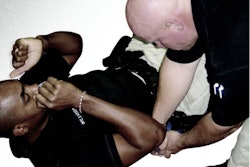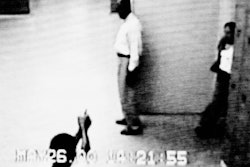Sometimes things go bump in the night. When they do, often law enforcement officers are summoned to deal with the situation. Whether the problem’s source happens to be someone’s imagination, the wind, or a felon bent on bloody mayhem, cops have to check it out.
Prowler calls are dispatched many times each day. And I don’t have to tell you that much of the time the investigating officers can’t find the source of the scare. Other times, the trouble is found to have emanated from a harmless source such as the breeze slamming a door.
Because officers so seldom discover an obvious threat when they investigate prowler calls, it’s easy to become complacent. Don’t let that happen to you. Carelessness can set you up for potential disaster.
Dangers abound on prowler calls. Officers have been hurt by clotheslines, sprinkler heads, and holes in the ground. They have been attacked by dogs, fallen over yard furniture, and even been threatened by citizens who thought they had found a prowler.
These are the hazards that you face even when no prowler is present. When a suspect is actually on the scene, things can get real dicey in a hurry.
Part of the problem comes in identifying a prowler. A prowler can be just about anyone. He may be an upstanding citizen by day who happens to be a voyeur by night. He may be an armed rapist. Or he may be a drunk at the wrong door.
Making assumptions about the source of a prowler complaint can get you hurt…or worse. All you can assume safely is that every prowler call holds the potential for danger.
If you are the peacekeeper sent to solve the mystery of something amiss in the night, there are several steps you can take to avoid becoming a casualty. Let’s take a look at some of them.
Keep Surprise on Your Side
In most instances, your aim will be to surprise a prowler, not allow him to surprise you. That means that you should approach the scene quietly, with no racing engines and no sirens wailing.
When you arrive, park away from the address where the prowler was reported, but realize that he could have traveled a long distance since the call came in. Watch for suspicious pedestrians or vehicles leaving the area.
Don’t slam your car doors or let your radios squawk when you leave the car. Move quietly, silencing any jangling equipment. If you talk to someone, such as a partner, speak quietly. Don’t create a target by back-lighting yourself or giving your location away with excessive use of your flashlight.
Keep looking for anything or anyone out of place. Clues to the presence of an offender could range from barking dogs to tracks on a wet lawn to open gates. Stay alert. Detain and question people who have no logical explanation for their presence.
You already should have had your dispatcher notify the caller that you are on-scene. The dispatcher also should tell the caller that you will be contacting him or her at the front door so that you don’t receive a load of buckshot as a welcome. The dispatcher additionally should have asked the reporting party to secure any weapons that may have been unlimbered.
There are situations that require a much less stealthy response. You can make all the code three commotion you want on your way to the scene if your information indicates that an offender is actually trying to enter the caller’s place of safety, or has already forced entry. This is now more than a prowler call. It could be a major crime in progress and, in this situation, causing the offender to leave his potential victim is more important than capturing him immediately. You want him to know that the cops are coming and that he should flee.
Still, you never throw caution to the wind.
Know the Situation
Get as much information as you can from dispatch before you arrive at a prowler call. Once you arrive, make contact with the complainant to learn more. (Remember, dispatch should tell the caller that you have arrived and will be contacting him or her.)
Ask the complainant the following questions: Was someone seen? What did he look like? Where was he last seen or heard? Any idea about his identity? Was a weapon seen? And so on. Also find out about other hazards. Are there animals or other “surprises” on premises? Are there any innocent people that the complainant knows to be outside? Are there any additional hazards you need to know about?
Always contact the caller again before you leave. Report what you found or did not find. Offer to check inside a residence, as well as outside. Comforting the caller is part of your job on a prowler assignment, so take as much time as necessary to calm and reassure an agitated person. Doing so may help prevent a return call.
Work with a Partner
A prowler call is not an assignment to undertake alone. Wait for your backup before you begin a search. Once your backup arrives, brief him or her on what you have learned so far. Then, once the search begins, move in coordination with your backup and stick together. This advice breaks with the older (and more dangerous) technique in which officers split up in an attempt to trap an offender.
Contact-and-cover tactics should be practiced during a prowler search. Your partner can’t cover you if he or she is elsewhere, out of sight. Consider applying building search procedures in which you take turns moving while the other covers.
If you encounter a suspect, issue commands like “Police! Don’t move!” that are clear to the suspect and to your backup. Hold your position and don’t move in close until your partner can cover you.
Make a Thorough Search
Search anywhere a human body, especially a small and flexible one, might be concealed. Don’t forget to check above your head because low-hanging roofs or trees can offer a hiding spot for a prowler.
Approach a thorough and systematic prowler search by asking yourself where you would hide given the options available. Be sure to check the following:
• In, under, and around trees, shrubs, and bushes
• In window wells and under stairs and decks
• Under, behind, and inside stacked objects such as boxes and lawn and garden furniture
• Under and inside vehicles, boats, and campers.
Remain mindful that a prowler may come up with some unique hiding places. One was found inside a relatively small doghouse. Another was found beneath plywood that appeared to be lying almost flat on the ground.
If you complete a search without finding anything, but you remain suspicious that something isn’t right, do it again. If you have a K-9 and handler team quickly available, utilize the dog’s nose to check the area. You also may want to remain parked quietly nearby for awhile to see if someone comes out of hiding once he or she thinks the cops have departed.
Stay Sharp at All Times
Do not make the dangerous assumption that there was never a prowler just because you don’t find one. Assume the presence of an offender until a careful search proves otherwise.
Remember, complacency is your enemy. Be prepared for unexpected things to happen, like an animal darting out from a hiding place or a neighbor yelling a question during your search.
Most officers handling a prowler search tend to not have a sidearm in hand unless they have information that the prowler is armed. If you do have your weapon out, keep your finger outside the trigger guard. You don’t want to shoot yourself or your cover if you stumble or are startled.
Challenge any unknown party you encounter during your search. Identify yourself and issue your control orders. Identifying yourself as “the police” is vital, since you do not want a subject you had to subdue claiming he didn’t know he was confronting an officer in the dark. Remember, your subject may not be alone. Stay vigilant for new threats. Assuming that a prowler call is a low priority, “nothing” assignment could get you killed. All prowler assignments hold the potential for disaster. Keeping your wits about you and taking the time to do it right could make the difference in your going home safely at end of watch—or not.
Be Careful in a Foot Chase
It is not unusual to end up in a foot chase on a prowler call. A desperate prowler may decide to fight or flee.
If your suspect runs, the application of some basic safety tactics will help you stay healthy while he or she ends up in custody.
Shout a command the moment the suspect begins to run and several times thereafter. Use commands like “Police! Don’t run!” and “Stop where you are!” The subject may comply, particularly if you’ve jumped an “innocent party.” If you are chasing a bad guy that you eventually have to subdue, your verbal instructions will serve as evidence to any witnesses that you tried to do it another way.
If the chase continues, let the suspect choose the path and discover the hidden obstacles, like holes, curbs, and vicious dogs.
Do not get reckless as you run; allow the suspect to do that. If you lose sight of him, slow down and do not run blindly into an area where you cannot see what’s ahead. He or she may be waiting in ambush. Stop, behind cover if possible, and listen for noises that may give his or her location away. Coordinate your actions with your backup and stay together.
Remember that a fleeing prowler you are gaining on may stop and attack. Be ready. Once you do catch up with your running suspect, try to avoid wrestling with him or her on the ground. That’s highly risky. Instead, upon getting within arm’s reach, push the suspect—hard—so that he or she tumbles out of control to the ground.
Stop, stay out of his reach, and draw the appropriate weapon. If you believe that he or she is armed, have your firearm in hand. Deliver clear orders like “Stay down!” “On your stomach!” “Hands on your head!” “Don’t move again!”
Remain out of reach of his arms or legs and keep the suspect covered until your backup becomes fully involved. Then, carefully handcuff the suspect from behind. Search the suspect thoroughly and repeatedly. Do not relax your vigilance while he or she is in your presence.
Hide and Seek
It’s critical to your safety and to the complainant’s peace of mind that you conduct a thorough search for the prowler.
There are basically three reasons that a prowler will hide:
• To ambush you
• To escape capture
• To escape capture so that he or she can attack the home owner who called you to the scene.
When conducting a search for a prowler, ask yourself, “Where would I hide?” But don’t limit yourself to hiding places that would fit you. Some prowlers are very small and
very limber.
Be sure you check the following common hiding places:
• In, under, and around trees, bushes, and shrubs
• In window wells
• Under stairs
• Under decks
• Behind objects like trash cans or utility sheds
• Behind woodpiles
• Under or inside cars and boats
• Under or behind lumber piles
• Behind or inside doghouses.
Danger Zone
The greatest danger that you face at any prowler call is, of course, violent action by the prowler. But odds are that, if you are injured while investigating a prowler call, it won’t be at the hands of a bad guy. The average backyard in Anytown America is an obstacle course of potential hazards, especially at night.
When investigating a prowler call, be sure to keep your eyes open for the following backyard hazards:
• Dogs and other animals
• Sprinkler heads
• Children’s toys
• Holes in the ground
• Garden and lawn tools
• Playground equipment
• Lawn furniture
• Clotheslines
• Planters
• Anything else that you could trip over or fall into.
Finally, be aware of any people who are in the backyard who are not prowlers. Ask the complainant if any neighbors or members of their household are in the yard. This is especially important if any of the neighbors or family members are armed. You don’t want to be shot by an upstanding but nervous citizen who thinks you are the prowler.
Follow the Officer Survival Basics
Everything you have ever learned about officer safety should be applied on a prowler call. Recall the “deadly sins” you had drummed into your head during the academy. You cannot afford to commit any of them now.
• Don’t rush when speed is not required.
• Do not get too close, too soon.
• Don’t work alone.
• Assume nothing that you don’t
know for a fact.
• Handcuff and search carefully.
• Practice careful weapon retention.
• Wear your body armor.
• Never cut corners when it comes
to safety.
Continue to follow good survival tactics when you take someone into custody. Occasionally officers make the mistake of assuming that a captured prowler represents nothing more than a curious teenager or a slimy pervert who is no real threat to their safety. Nothing could be further from the truth.
Prowlers may be armed. They may be in the process of committing a serious crime, or fleeing from one. Murderers, rapists, fugitives, and burglars have been snared by officers looking for a prowler. Even “lost” drunks with their diminished inhibitions and judgment may attack you.









